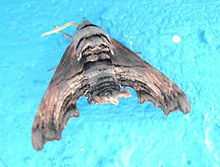Sphecodina abbottii
| Abbott's sphinx | |
|---|---|
| | |
 | |
| Conservation status | |
| Not evaluated (IUCN 3.1) | |
| Scientific classification | |
| Kingdom: | Animalia |
| Phylum: | Arthropoda |
| Class: | Insecta |
| Order: | Lepidoptera |
| Family: | Sphingidae |
| Genus: | Sphecodina |
| Species: | S. abbottii |
| Binomial name | |
| Sphecodina abbottii (Swainson, 1821)[1] | |
| Synonyms | |
| |
Abbott's sphinx (Sphecodina abbottii) is a moth of the Sphingidae family. It lives in eastern North America.
Adults fly in May–June in the north, but have several generations in the south. The underwings have a strong yellow band and in flight, the moth buzzes, appearing like a bee. At rest, they raise their abdomens and are well camouflaged on tree bark, looking like a broken branch (Wagner, 2005).
Early instars are a pale greenish-white, with at first a horn, but later a brown knob near the hind end. Final instars (75 mm in length) come in two patterns: one has brown bands such that there are ten large pale green spots on the back and an eyespot on the rear. This form may mimic grapes. Others are completely brown, with a wood-grain patterning, and with the rear eyespot. (Wagner 2005) In the final instar the knob looks a lot like a vertebrate eye, down to the white reflection spot. If it is pinched or poked, the larva squeaks and bites at the attacker (Wagner 2005). Larvae feed on grapes (Vitis) and Ampelopsis.
References
- ↑ "CATE Creating a Taxonomic eScience - Sphingidae". Cate-sphingidae.org. Archived from the original on 2012-11-05. Retrieved 2011-10-26.
- Wagner, DL. 2005. Caterpillars of eastern North America. Princeton Univ. Press.
And Poland
External links
- Abbott's sphinx Moths of America
- Abbott's sphinx